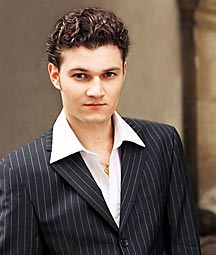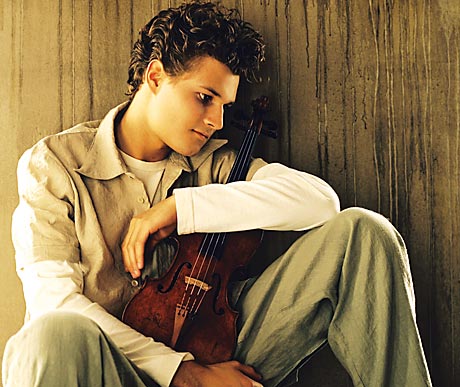Alexandre Da Costa - Coming Home by Réjean Beaucage
/ November 2, 2004
Version française...
 Violinist Alexandre Da Costa is coming
back to Canada this month for a number of concerts and the release of a new CD
of works for solo violin. This recording -- his fifth with Disques XXI-21 --
gives us a chance to hear, in all its splendour, the Baumgartner Stradivarius
loaned to him by the Canada Council for the Arts. The new release includes
Bach's Sonata No. 1 and Ysaye's Sonata No. 2, as well as André
Prévost's Improvisation and Robert Lafond's Solitario, the latter
being the title of the CD. Violinist Alexandre Da Costa is coming
back to Canada this month for a number of concerts and the release of a new CD
of works for solo violin. This recording -- his fifth with Disques XXI-21 --
gives us a chance to hear, in all its splendour, the Baumgartner Stradivarius
loaned to him by the Canada Council for the Arts. The new release includes
Bach's Sonata No. 1 and Ysaye's Sonata No. 2, as well as André
Prévost's Improvisation and Robert Lafond's Solitario, the latter
being the title of the CD.
?"I've worked on almost all Ysaye's sonatas, and of
course, I plan to do an album of just his works in the near future, even though
his music isn't the most accessible. For example, I could do the six sonatas,
but that isn't a program that everyone would appreciate. Ideally, each violinist
would want to do all of Bach, Paganini, and Ysaye. To be practical, however, you
have to concentrate on one of them and I've chosen Ysaye. I find that he shares
many of Bach's and Paganini's qualities. This CD has a Bach piece on it as well
as André Prévost's Improvisation, which I've played for years and which I
brought with me to Vienna, Spain, and France--in fact almost everywhere. It was
important to have it with me. And then there's a brand-new Robert Lafond piece,
composed just for me, which I'm very happy with."
?After a number of years giving concerts in Europe,
where he's achieved much success, the Montreal musician is looking to recapture
the Canadian market. "I've been in Europe for five years. My agents are mainly
in Europe, but now I have a new agreement with an agent here. When I left at the
age of eighteen, I played both piano and violin, but it's as a violinist that I
want to get myself known now. I've had the pleasure of working with Europe's
best teacher, Zakhar Bron, at the Escuela Superior de Música Reina Sofia de
Madrid [Maxim Vengerov and Vadim Repin's teacher] and this is what I'd like to
share with audiences."
?Da Costa is equally at home on the piano and
violin, something fairly rare for professional level musicians. His very first
CD, with Amberola, included pieces by Robert Schumann and Pierre-Max Dubois
played on piano, and others by Pablo de Sarasate, Camille Saint-Saëns, and
Vittorio Monti played on the violin. "I studied both instruments seriously, but
above all, I studied music, and learning one helped to learn the other. Now,
from a technical standpoint, I'm really specializing in violin. I've had the
help of a great master and I think I can say without boasting that I'm ready to
perform everything one can expect from a soloist." Indeed, at age twenty-five Da
Costa has now reached a truly exceptional performance level as can be heard on
his CD released last year. "I recorded it with Christian Frohn, who is the first
viola player and soloist with the Vienna Philharmonic. He is an excellent
musician with whom I performed Mozart's Symphonie Concertante in
Sarajevo. For that CD we recorded arrangements of music from The Magic
Flute and two Mozart duos (KV 413 and 424), as well as the
Passacaille by Handel and Halvorsen."
Stradivarius
Da Costa's persevering approach has earned him
major recognition from the Canada Council for the Arts who rewarded him with a
three-year loan of a magnificent violin--the Baumgartner Stradivarius of 1689.
"It's a fabulous instrument!" says Da Costa. "It is helping my career on more
than one level. I now get more attention from some conductors who wouldn't have
thought of me before. My previous violin, an 1842 Jean-Baptiste Vuillaume, was
also a very good instrument, and worth far more than I could afford. Each violin
has its advantages and disadvantages. For example, the two instruments differ in
power. Of course the Stradivarius is now my preferred instrument. I'll certainly
feel a bit sad to have to give it back at the end of the three-year loan!
Contrary to what you might think, it's not an easy instrument to play. In
Vienna, where I live, some of my friends were curious and wanted to try it. They
were really surprised to find it difficult."
?Although audiences don't often think about the way
instruments get passed around, it is a reality soloists at the start of their
careers have to reckon with. "At first I said to myself, 'Wow! A violin worth
three million dollars!' I treated it with extreme care, left it at home, and so
on. But it's my working instrument and I have to have it with me at all times,
in the street, the metro, the plane, or coming back to the hotel after a
concert. I come from an artistic background: my mother is a painter and my
father is in the theatre. It's not a milieu where there's a lot of money, and I
would never have been able to pay for an instrument that would enable me to make
a career in music. Therefore, I started with a modern Canadian violin provided
by a foundation, and that's what I took to Europe. My teacher introduced me to a
number of people and eventually I was able to get a superb Ruggieri for six
months. It had belonged to Yan Kubelik. Then I was lent a Balestrieri. Following
a concert in Montreal, a music-lover decided to help and bought the Vuillaume in
order to lend it to me. Then I entered the competition for the Canada Council
instrument bank, and here I am with a Stradivarius [and a Sartory bow, lent by
the Canimex Foundation, which Da Costa uses with one of the 300 varieties of
string provided by the Thomastik Company]. Things move quickly in the music
world!"
Working with the greats
Da Costa's homecoming is well orchestrated. Between
May 15 and July 15 2004, he appeared on stage eight times. Guest soloist for the
sixtieth anniversary of the Conservatoire de Musique de Montréal held at the
Place des Arts, he then participated in the Stradivarius evening at the Montreal
Chamber Music Festival before giving a recital with Marika Bournaki at the
Domaine Forget. These numerous appearances reinstated him in the eyes of his
Canadian public.
?In October Da Costa was invited to play with the
Extremadura Symphony Orchestra in Spain for three programs, during which he gave
a rare performance of the Concerto for Violin (1916) by Portuguese
composer Luis de Freitas Branco. He later made the first-ever recording of
Branco's work, which will be released by Disques XXI-21. On November
11th, he will perform as soloist in Vivaldi's Four Seasons,
appearing in Spain's largest concert hall, the National Auditorium of Spain in
Madrid, with the Cordoba Symphony conducted by Gloria Isabel Ramos
Triano.
The day after this concert, Da Costa returns to
Canada to give three recitals. His program includes Brahms's Third
Sonata, Manuel de Falla's Popular Songs, an Ysaye sonata, and works
by Kreisler and Sarasate. These will be given on November 17th at the
Rivière-du-Loup Cultural Centre, on November 20th at the Salle
Albert-Dumouchel in Valleyfield, Quebec, and on November 26th at the
Central United Church in St. Thomas, Ontario. Two days later, he will appear at
a benefit concert at the Salle Claude-Champagne in Montreal marking the
twenty-fifth anniversary of the music program at Pierre-Laporte High School...
and its possible disappearance! The prospect touches a sensitive nerve in Da
Costa. "It was my school! The proposed cuts are, in my humble opinion, a
cultural disaster, and I'm committed to defending the program that enabled me to
develop and gave me the time and the environment to do research and pursue
artistic excellence. It would be very sad to see this unique program abandoned.
To shut down a program that is open to all, whatever their financial status,
will also confirm a false belief, which is that classical music is only for rich
people. It's just the opposite, and I'm a perfect example of this. The
Pierre-Laporte School is one of the organizations, along with the Conservatoire
de Musique de Montréal, that allowed me to get a top-ranking musical education
that was financially accessible."
?Da Costa will "rest" in the early part of 2005.
"January and February are a very important time in my concert schedule. This is
the time I give myself to prepare the new repertoire for my spring and fall
series."
?His agenda for the months following is impressive.
"In early March 2005, I'm expected in Vienna for two concerts at the Château
Laxenburg and a recording session with the Vienna Symphony's chamber orchestra
conducted by Christian Schulz. I'll do the Four Seasons. A few days later
I'll begin a five-concert tour in northwest Germany with the Nordwestdeutsche
Philharmonic conducted by Camil Marinescu. Bruch's Concerto is on the
program. In April, I have two highly technical performances of Paganini's
Concerto No. 2 on my schedule: on April 16 with the Malaga Symphony
conducted by Francisco de Gálvez, and on April 24 with the Hamburg Symphony at
the Musikhalle, conducted by Martin Haselbeck. In June 2005 I'll be performing
Tchaikovsky's Concerto at the Baden Casino in Austria with the Baden
Sinfonietta, and I'll make my début at the famous Musikverein in Vienna. I'll be
playing the Four Seasons again with the Vienna Symphony."
?Da Costa's increasingly frequent trips home have
begun to stimulate offers. "Last summer I took part in the Canada Music
Competition, which is important for me because that's where I began [by winning
first prize in the violin and piano categories!]. I also took part in the
Jeunesses Musicales gala in Trois-Rivières and at the music camp in the
Laurentians where I was invited to teach by Raymond Dessaints and Johanne Arel,
my teachers at the Conservatoire. I'm honoured that my former teachers have
shown their confidence by letting me teach their pupils for two weeks! People
have seen that I'm coming back to Quebec and word has got around. Emails have
started arriving. For the moment there's talk of a concert with the Montreal
Symphony Orchestra for the 2005-2006 season. I'm already doing these kinds of
concerts in Europe, but I'm very pleased with the invitation to do it on my home
turf. I hope people will realize that I'm a big boy now!"
[Translated by Jane
Brierley]
Version française... |
|


